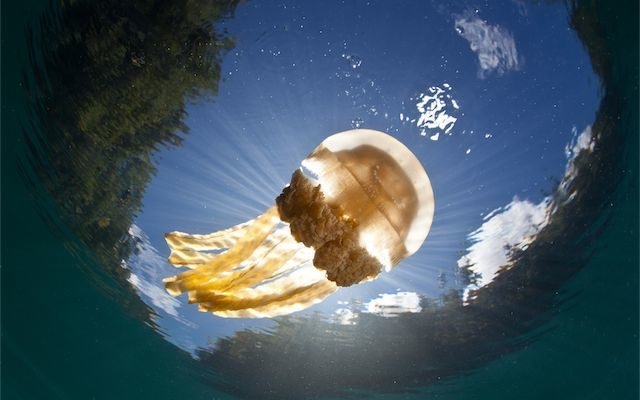Say goodbye to Fish and the things that eat them.
We evolved in a world with abundant seas of fish and shellfish to feed us. If we keep burning mountains of carbon, Say goodbye to that world.
Throughout human history, our civilizations have thrived on the coasts near rich fisheries. A source of sustainable protein and nutrients which could sustain life on land and in the seas for millions of years to come.
The seas of earth have always seemed a limitless resource. Yet at this point we have overfished nearly every species we have ever valued. Some to the point of extinction, some to depletion, and most to unhealthy low populations and small size. Fishing the seas is the classic example of the “tragedy of the commons” in which the logic of the mob destroys a common resource.
But that’s nothing compared with CO2 acidification and greenhouse warming of the seas.
If we had put our civilization on a crash program to figure out how to kill all complex life in the seas and keep it dead for a million years, we could not have come up with a more efficient way than to acidify the oceans by burning carbon.
The oceans are the great CO2 sponge. In one way that’s good news, for otherwise we’d be well past the point of heating the planet beyond habitable temperatures. But in another way, it’s terrible news, because it means humans can kill the complex life of the oceans, and get get that hellish task pretty well done within the lifetimes of kids now in high school. They were born into one world and will mostly outlive it, as things are now going.
First to go will be the surface organisms which utilize aragonite for their skeletons, shells, and teeth. The planktonic animals at the base of the most productive oceanic food chains. Then the snails and crabs and other creatures; the cuttlefish, the huge percentage of ocean life which is based on calcium carbonate for structure. As those are lost, the complex food webs become chaotic, as species which have evolved for certain prey at certain times of their lives suddenly find it gone.
At the same time, the roughly 30% of migratory fish which spawn around coral reefs will have the coral reefs fizz into nonexistence, graveyards of former life. They’ll die, and the things that eat them will die in turn.
The larger and higher on the food chain a sea creature is, the more likely that it will not survive food web collapse. Tuna, salmon, halibut, cod… name any large ocean fish; it will likely disappear. This also goes for the wide array of other ocean life which eats the small fish and animals which rely on calcium carbonate.
The food chains will tend to shift to dinoflagellate-based plankton with many low-energy steps in the food chain, meaning seas of jellyfish, sessile organisms like sea cucumbers and salps, mats of algae and bacterial slimes.
As the oceans continue to warm in the centuries to come, they will stratify and largely stop upwelling nutrients from below, and the bacteria which create toxic hydrogen sulfide gas will begin to thrive in many more places.
The remaining humans, if there are any, will face a planet in which the seas are hostile, odious, and for the most part devoid of complex nutritious sea creatures to feed us. Permanently.
But at least we didn’t have a carbon tax. That might have affected the stock market.
Research: Simpler organisms better suited for climate change
Summary: The simpler a marine organism is structured, the better it is suited for survival during climate change, researchers have discovered this in a new meta-study. For the first time biologists studied the relationship between the complexity of life forms and the ultimate limits of their adaptation to a warmer climate. LINK TO SCIENCEDAILY STORY.
Turns out that acidification isn’t working alone. The ocean heating caused by CO2 strikes at the metabolisms of the same complex creatures which will suffer most from food web collapses. Indeed, an acidified world with heated oceans drastically favors simple organisms.
“The simpler a marine organism is structured, the better it is suited for survival during climate change. Scientists of the Alfred Wegener Institute, Helmholtz Centre for Polar and Marine Research, discovered this in a new meta-study, which appears today in the research journal Global Change Biology. For the first time biologists studied the relationship between the complexity of life forms and the ultimate limits of their adaptation to a warmer climate. While unicellular bacteria and archaea are able to live even in hot, oxygen-deficient water, marine creatures with a more complex structure, such as animals and plants, reach their growth limits at a water temperature of 41 degrees Celsius. This temperature threshold seems to be insurmountable for their highly developed metabolic systems.”
“The new research results also provide evidence that the body size of an organism plays a decisive role concerning adaptation limits. Smaller animal species or smaller individuals of an animal species can survive at lower oxygen concentration levels and higher temperatures than the larger animals.
“We observe among fish in the North Sea that larger individuals of a species are affected first at extreme temperatures. In connection with climate warming, there is generally a trend that smaller species replace larger species in a region. Today, however, plants and animals in the warmest marine environments already live at their tolerance limit and will probably not be able to adapt. If warming continues, they will migrate to cooler areas and there are no other tolerant animal and plant species that could repopulate the deserted habitats,” says Prof. Dr. Hans-Otto Pörtner of the Alfred Wegener Institute. The biologist initiated the current study and is the coordinating lead author of the chapter “Ocean systems” in the Fifth Assessment Report.”
“The new meta-study shows that their complex structure sets tighter limits for multicellular organisms, i.e. animals and plants, within which they can adapt to new living conditions. Individual animal species can reduce their body size, reduce their metabolism or generate more haemoglobin in order to survive in warmer, oxygen-deficient water. However, marine animals and plants are fundamentally not able to survive in conditions exceeding the temperature threshold of 41 degrees Celsius.”
The temperature windows of some ocean dwellers as a comparison: the figures for green algae, seaweed and thermophilic bacteria were determined in the laboratory. The fish data stem from investigations in the ocean.
Credit: Sina Löschke, Alfred Wegener Institute
Eating Jellyfish & Algae…
It can be done, but there isn’t much to it and it isn’t very good. Gonna need a lot of ketchup, and to eat a huge amount to get enough nutrients to survive.
Sound good?
We’ve always thought about fish and nutritious seafood as a renewable resource. Because it always has been. If we had never started digging up black stuff and burning it, it would have been around as long as we needed it. But now we’re closing that door for hundreds of thousands, maybe millions of years.
But it hasn’t happened yet. All we need to do is stop. There has never, ever, been more at stake. No war has been more important, no social justice so vital, no plague so irrevocable.
We can have seas of fish, or we can have another few decades of smokestacks. We can’t have both.





















